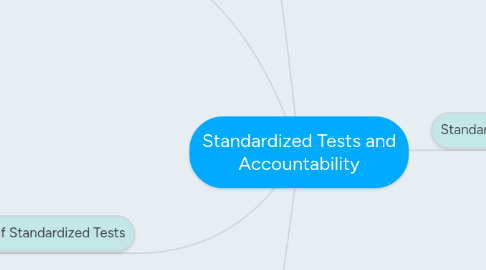
1. Standardized Tests How and Why
1.1. Standardized tests are typically given under the same conditions to thousands of similar students for whom the test is designed which establishes norms for comparison
1.2. Selection and Placement - standardized tests are used to select students for entry or placement
1.3. Diagnosis - standardized tests are used to diagnose individual students' learning problems or strengths
1.4. Evaluation and Accountability - standardized tests are used most commonly to evaluate students' progress and teachers' and schools' effectiveness
1.5. School Improvement - standardized tests can contribute to improving the schooling process
2. Types of Standardized Tests
2.1. Aptitude Tests - designed to assess abilities
2.1.1. General Intelligence Tests - general aptitude for school learning
2.1.2. Measurement of IQ - scale developed to measure intelligence
2.1.3. Multifactor Aptitude Test - provides a breakdown of more specific skills
2.2. Achievement Tests
2.2.1. Predict students' future performance in a course of study
2.2.2. Diagnose students' difficulties
2.2.3. Serve as formative tests of students' progress
2.2.4. Serve as summative tests of learning
2.3. Norm-Referenced Achievement Test - assess knowledge
2.3.1. Achievement Batteries - measure achievement in a variety of subjects
2.3.2. Diagnostic Tests - focus on specific content areas and emphasize skills important for mastery
2.3.3. Subject Area Achievement Tests - purchased tests
2.4. Criterion-Referenced Achievement Test - assesses knowledge
3. Interpretation of Standardized Tests
3.1. Derived Scores - what raw scores are translated into
3.1.1. Percentile Scores - percentage of students in norming group scored lower than particular score
3.1.2. Grade-Equivalent Scores - relate students' scores to the average scores of particular grade level
3.1.3. Standard Scores - normal distribution
3.1.3.1. Standard Deviation - measure of the dispersion of scores
3.1.3.2. Stanines - have a mean of 5 and a standard deviation of 2. Each stanine represents 0.5
3.1.3.3. Normal Curve Equivalents - can range from 1 - 99 with a mean of 50 and a standard deviation of 21
4. Issues Concerning Standardized & Classroom Testing
4.1. Test Validity - extent to which inferences are justified
4.1.1. Content Evidence of Validity - whether test assesses what the user wants to assess
4.1.2. Criterion-Related Evidence of Validity - looking at relationships between scores
4.1.2.1. Predictive Evidence - measure of tests ability to help predict future performance
4.1.2.2. Concurrent Evidence - determines if test measures same domain as another test
4.1.2.3. Discriminant Evidence - show relative lack of relationship with some variables
4.2. Test Reliability - accuracy with which skills and knowledge are measured
4.3. Test Bias - exhibit lower or higher scores for demographic groups
4.4. Computerized Test Administration - use computers to administer tests
4.5. Testing Accommodations for Students with Disabilities
4.6. Testing Accommodations for English Learners
5. How Educators Held Accountable for Student Achievement
5.1. Test scores are frequently used in decisions about hiring, firing, promotions, and transfers
5.2. No Child Left Behind
5.2.1. Annual Testing - under NCLB all states had to test students in reading and math
5.2.2. Disaggregated Reporting of Scores - under NCLB states had to report test scores for each school to each subgroup
5.2.3. Adequate Yearly Progress (AYP) - All subroups in all schools were expected to make adequate yearly progress
5.2.4. Consequences for not Meeting AYP - subject to various consequences under NCLB
